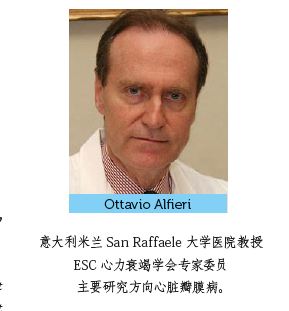
《国际循环》:很多瓣膜疾病的处理都非常困难,低流量低梯度主动脉瓣狭窄是个问题吗?
O Alfieri教授:低流量低梯度主动脉瓣狭窄是个新难题。其通常有两个亚型,一个亚型射血分数降低,另一个亚型射血分数正常。后者也被称之为矛盾的低流量低梯度主动脉瓣狭窄。该病的自然史通常较差,置之不管患者会非常快地死亡,因此绝对有必要进行干预。有一个非常重要的观察发现,与标准主动脉瓣狭窄患者相比,该类患者存在更高的手术风险。此外,鉴于该病患者的移植瓣膜更容易出现不匹配,其手术后晚期发病率及死亡率更高。因此。对低流量低梯度主动脉瓣狭窄这一特殊类型患者而言,与外科主动脉瓣置换术相比,选择TAVI可能是更明智的选择。
《国际循环》:本次大会上是否有有关继发性二尖瓣关闭不全的新信息?您一般会在何时对退行性二尖瓣关闭不全患者进行治疗或转诊行经导管二尖瓣关闭不全修复术?
O Alfieri教授:所谓的继发性二尖瓣关闭不全患者通常既往有心肌梗死病史或心肌病。今天上午的大会就重度二尖瓣关闭不全与重度主动脉瓣狭窄的临床关系进行了探讨。大会上报告了一例同时合并严重主动脉瓣狭窄与严重二尖瓣关闭不全伴二尖瓣环大量钙化的87岁老年女性患者。仅采用TAVI治疗主动脉瓣狭窄,并不能减轻二尖瓣关闭不全,但患者感觉会变好。对该老年女性而言,鉴于其二尖瓣环存在严重钙化,故难以针对二尖瓣关闭不全进行处理。在患者对主动脉瓣狭窄治疗结果满意的情况下,可不对二尖瓣关闭不全作处理。
《国际循环》:不同患者不同病情如何选择瓣膜?
O Alfieri教授:对该患者而言,我们现在有很多可供选择应用的瓣膜如机械瓣膜、生物瓣膜。我们现在无需开胸即可经导管应用生物瓣膜,需要为合适的患者选择适宜的瓣膜。当然,目前来说,鉴于生物瓣膜的持久性更好且更具血流动力学优势,世界范围内生物瓣膜的应用会越来越多。即使生物瓣膜后期发生退化,还可采用无创的方式再植入瓣膜。这是一个巨大的优势。此外,患者通常不喜欢抗凝治疗,而应用生物瓣膜时患者无需进行抗凝,故生活质量会更高。另外,与机械瓣膜相比,生物瓣膜的并发症更少。机械瓣膜容易突发瓣膜血栓这一晚期并发症,容易出现晚期大出血,尤其是颅内大出血。与之相比,应用生物瓣膜时发生突发事件及不良事件的可能性均较低;其虽然会发生退化,但这毕竟是个非常缓慢的过程。另一个需要决定的重要问题是采用外科手术植入生物瓣膜还是经导管植入生物瓣膜。这是当下非常重要的一个问题。目前来看,其原则还是要尊重患者的意愿。当然,患者肯定愿意选择创伤更小的治疗方式。不久的将来,我们有望采用TAVI对中危患者进行治疗。目前,限制TAVI应用的主要问题是成本及报销问题。
IC: There are many difficult cases in valve disease. Is low flow low gradient aortic stenosis a problem?
OA : Certainly these is a new entity. Low flow, low gradient aortic stenosis has basically 2 subtypes of low flow, low gradient aortic stenosis. One type is with the reduced ejection fraction and the other type is with a normal ejection fraction. The last one is also called paradoxical low flow,low gradient aortic stenosis. This entity has a very poor natural history so intervention is absolutely needed, because left alone these patients die very quickly. There is another observation which is very important, that these patients submitted to surgery have a higher operative risk compared to standard aortic valve stenosis. They also have not only higher surgical risk, but also the late morbidity and mortality is higher because more often these patients prosthesis is mismatched. In this particular group of patients, it is probably wise to be more liberal in using TAVI instead of surgical aortic valve replacement.
IC : Are there any new information about secondary mitral regurgitation at this meeting and when should you treat or refer your degenerative mitral regurgitation patients for transcatheter mitral regurgitation repair?
OA: You know this entity of so called secondary mitral regurgitation is often used for patients to have a previous myocardial infarction or for patients with cardiomyopathy. What was discussed this morning on the other hand, was the association of severe mitral regurgitation in the clinical context of patients with severe aortic stenosis. To be more specific, the case report was dealing with an old woman of 87 years with severe aortic stenosis and severe mitral regurgitation with a massively calcified mitral annulus. It was elected to treat only the aortic stenosis with TAVI. Hermitral regurgitation did not decrease after this treatment but the patient was doing much better. Once we have a very difficult problem of severe massive mitral regurgitation, which cannot be treated because in an old woman with a massive calcified mitral annulus. This is not possible to do it realistically, then this pathology can be left alone with the acceptable clinical results.
IC : Which prosthesis for which patients?
OA: Of course nowadays we have a big variety of valves to be used in patients. We have the mechanical valve, we have the bioprosthesis, and we have bioprosthesis to be used with the catheter without opening the chest. We have to choose the right prosthesis for the right patient. Certainly there is a tendency to use more and more bioprosthesis in the world, because bioprosthesis are nowadays better in terms of durability and also in terms of hemodynamics. In addition, the bioprosthesis, if they degenerate later on they can be treated with the valve in valve procedure, which is not invasive. This is a big advantage. Also the quality of life with bioprosthesis is much better, because there is no anticoagulation, and of course the patient likes not to have a problem of anticoagulation. The type of complication with the bioprosthesis is less dramatic than the complication that you can have with the mechanical valve, because the mechanical valve you can have suddenly the thrombosis developing of the valve. This is a later event, or you can also have massive hemorrhages in particular inside the brain, and this can be very late. On the other hand, with the bioprosthesis, the chances of having sudden events and unfavorable events is lower and you rather have structural valve degeneration, which is a chronic process. The other important point is to decide whether to use a surgical bioprosthesis, or a transcatheter bioprosthesis. This is an important issue nowadays, and the tendency is to follow the wishes of the patient. Certainly the patients are wishing for a less traumatic procedure. In this regard, it is quite possible in the near future even intermediate risk patients will be treated with TAVI. The only limitation is the cost of TAVI and the reimbursement problems.



 京公网安备 11010502033353号
京公网安备 11010502033353号